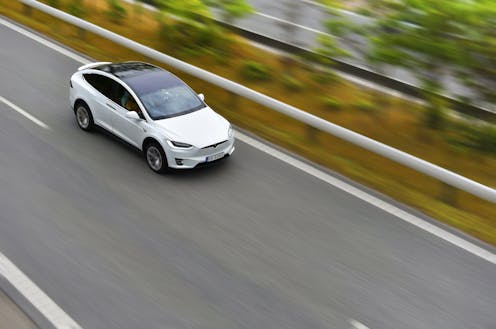How the ‘rebound effect’ could eat away at the green gains from electric vehicles
- Written by Milad Haghani, Senior Lecturer of Urban Mobility & Resilience, UNSW Sydney

The transport sector produces around 19% of Australia’s total greenhouse gas emissions. About 85% of transport emissions come from road vehicles burning fossil fuels.
In Australia’s Emissions Projections 2023, transport emissions are expected to rise from 2023 under the baseline scenario, returning to pre-pandemic levels. As the projected uptake of electric vehicles increases from 2030 to 2035, transport emissions are expected to fall.
While these projections are promising, the reality is more complex. Our new research has explored often-overlooked factors such as the rebound effect. It’s the phenomenon where energy-efficiency gains, such as those from electric vehicles, can lead to an increase in overall use.
We have already seen this effect at work in other nations that led the way in adopting electric vehicles. Fortunately, we also have evidence of how to manage the rebound effect to achieve the expected green gains from electric vehicles.
The rebound effect is widespread
When something becomes more efficient, cheaper or easier to use, people tend to use more of it. This can partially (and sometimes significantly) offset the expected benefits of greater efficiency.
The rebound effect has been well-documented in relation to many large-scale green initiatives, especially home energy-efficiency improvements when homes are retrofitted with better insulation or heating and cooling systems. With lower heating and cooling costs, some households then keep their homes at higher comfort levels for longer. This offsets some of the intended energy savings.
In the case of vehicle electrification, as cars become cheaper to own and run, people may end up driving more often or for longer distances. We are already seeing this in some countries.
A study from Stockholm, Sweden, during early stages of electric vehicle adoption found drivers made more trips and relied more heavily on their cars than non-EV users. The study participants generally perceived electric vehicles as being more eco-friendly than using public transport.
Drivers may also increase their speed and acceleration, knowing their vehicle is more fuel-efficient and driving has become cheaper. One study found a 20.5% rebound effect in journey speed for electric vehicles. This reduced the expected energy savings.
How much impact does this effect have?
Studies have found that if evaluations of environmental benefits ignore rebound effects, these benefits may be overstated by about 20% for reduced vehicle use and around 7% for reduced electricity use. Other studies have predicted more moderate effects.
You might ask, so what if travellers go longer distances? Aren’t electric vehicles still zero-emission? While they produce no tailpipe emissions, longer distances increase their environmental footprint in other ways.
More driving uses more electricity. If it comes from fossil fuels, it produces carbon emissions.
The manufacturing and disposal of electric vehicle batteries generate significant emissions too.
More driving leads to more road congestion and non-exhaust emissions from tyres and brakes.
In other words, zero-emission driving isn’t the whole picture.
Despite the rebound effect, electric vehicles will still have significant environmental benefits. But just how big these benefits are depends on how the vehicles are used.
What is the psychology behind this effect?
Understanding rebound behaviours is key to minimising the gap between expected and actual environmental benefits.
Research shows that while people may adopt pro-environmental behaviours, such as driving electric vehicles, they don’t always make rational, purely cost-driven decisions. It has been suggested factors like moral licensing — the idea that people feel entitled to behave less sustainably after making a green choice — drive this phenomenon.
More recent research has provided evidence that moral licensing is not the whole picture. Instead, environmental attitudes and demographic factors — such as age and gender — play a bigger role in determining subsequent climate-friendly behaviour. Younger men are least likely to behave in a climate-friendly manner. Older people and women are more likely to behave in sustainable ways.
Personal and social norms play a role in how people respond to energy-efficient technologies, but not always in expected ways. Pro-environmental values — where individuals genuinely care about their impact — are the most effective in preventing rebound effects. People with these values are more likely to adjust their consumption mindfully.
However, social norms can have the opposite effect. In some cases, people may adopt energy-efficient products like electric vehicles to meet societal expectations, but this can lead to what’s called compensatory behaviour. Feeling they’ve “done their bit”, they may justify using the vehicle more often. Or they might switch from public transport to driving.
What’s the solution?
Incentives and policies to promote electric vehicles are largely effective in cutting carbon emissions but can have unintended consequences.
The low running costs of these vehicles, along with incentives like toll or tax exemptions, may encourage more driving. This often happens at the expense of public transport, cycling and walking. Such incentives could also contribute to increases in vehicle ownership or city traffic.
Lack of knowledge about the full environmental impact of the choices they make can make people more susceptible to such unintended effects. When consumers are better informed, unintended consequences such as the rebound effect tend to diminish.
Raising awareness and providing targeted information could help counter behaviours that undermine the benefits of electric vehicles.
In the global push to combat climate change, simply reducing vehicle tailpipe emissions won’t be enough. To truly minimise transport’s impact, we must adopt a holistic approach that addresses the entire life cycle of vehicles—from production and use to disposal.
Authors: Milad Haghani, Senior Lecturer of Urban Mobility & Resilience, UNSW Sydney



















